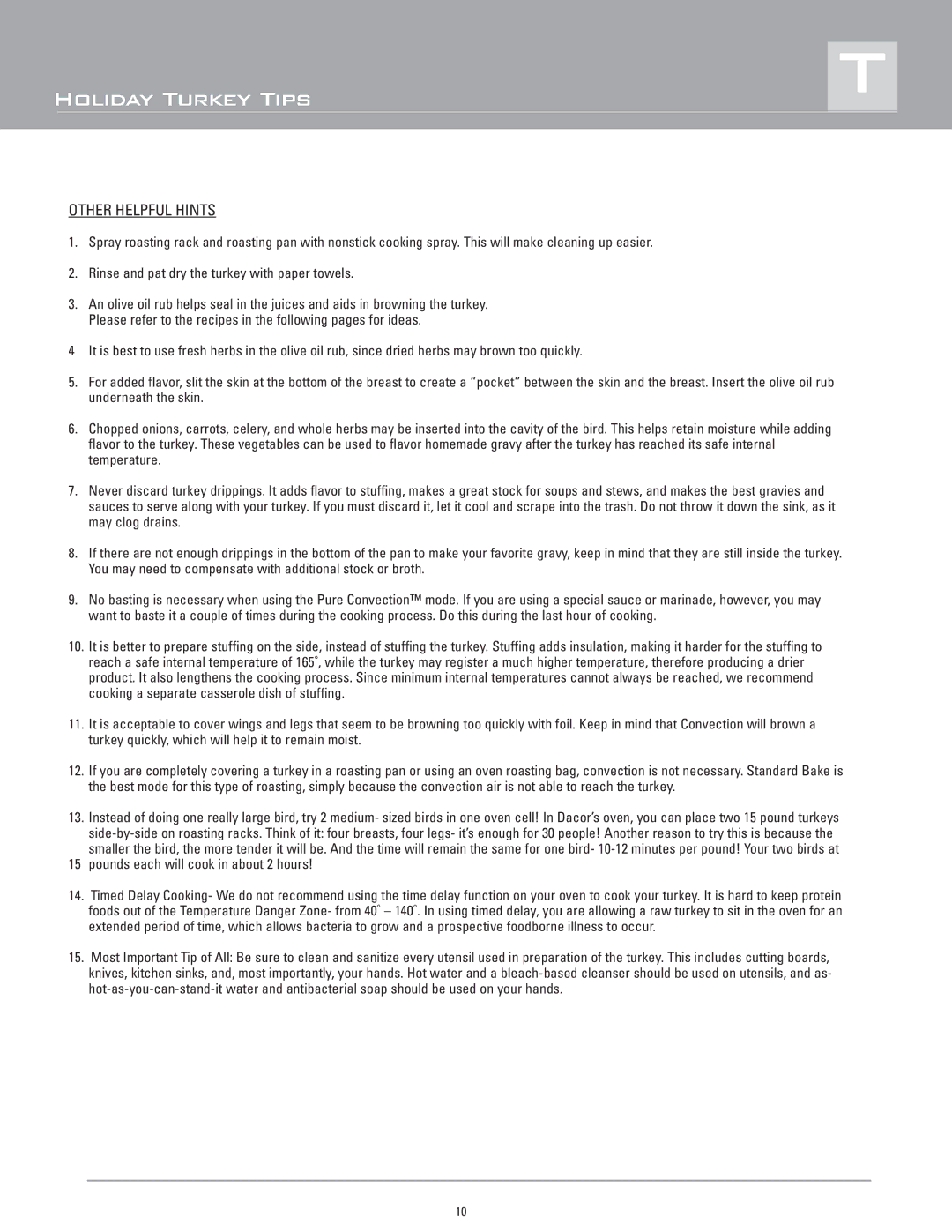
T
Holiday Turkey Tips
OTHER HELPFUL HINTS
1.Spray roasting rack and roasting pan with nonstick cooking spray. This will make cleaning up easier.
2.Rinse and pat dry the turkey with paper towels.
3.An olive oil rub helps seal in the juices and aids in browning the turkey. Please refer to the recipes in the following pages for ideas.
4 It is best to use fresh herbs in the olive oil rub, since dried herbs may brown too quickly.
5.For added flavor, slit the skin at the bottom of the breast to create a “pocket” between the skin and the breast. Insert the olive oil rub underneath the skin.
6.Chopped onions, carrots, celery, and whole herbs may be inserted into the cavity of the bird. This helps retain moisture while adding flavor to the turkey. These vegetables can be used to flavor homemade gravy after the turkey has reached its safe internal temperature.
7.Never discard turkey drippings. It adds flavor to stuffing, makes a great stock for soups and stews, and makes the best gravies and sauces to serve along with your turkey. If you must discard it, let it cool and scrape into the trash. Do not throw it down the sink, as it may clog drains.
8.If there are not enough drippings in the bottom of the pan to make your favorite gravy, keep in mind that they are still inside the turkey. You may need to compensate with additional stock or broth.
9.No basting is necessary when using the Pure Convection™ mode. If you are using a special sauce or marinade, however, you may want to baste it a couple of times during the cooking process. Do this during the last hour of cooking.
10.It is better to prepare stuffing on the side, instead of stuffing the turkey. Stuffing adds insulation, making it harder for the stuffing to reach a safe internal temperature of 165˚, while the turkey may register a much higher temperature, therefore producing a drier product. It also lengthens the cooking process. Since minimum internal temperatures cannot always be reached, we recommend cooking a separate casserole dish of stuffing.
11.It is acceptable to cover wings and legs that seem to be browning too quickly with foil. Keep in mind that Convection will brown a turkey quickly, which will help it to remain moist.
12.If you are completely covering a turkey in a roasting pan or using an oven roasting bag, convection is not necessary. Standard Bake is the best mode for this type of roasting, simply because the convection air is not able to reach the turkey.
13.Instead of doing one really large bird, try 2 medium- sized birds in one oven cell! In Dacor’s oven, you can place two 15 pound turkeys
15 pounds each will cook in about 2 hours!
14.Timed Delay Cooking- We do not recommend using the time delay function on your oven to cook your turkey. It is hard to keep protein foods out of the Temperature Danger Zone- from 40˚ – 140˚. In using timed delay, you are allowing a raw turkey to sit in the oven for an extended period of time, which allows bacteria to grow and a prospective foodborne illness to occur.
15.Most Important Tip of All: Be sure to clean and sanitize every utensil used in preparation of the turkey. This includes cutting boards, knives, kitchen sinks, and, most importantly, your hands. Hot water and a
10
